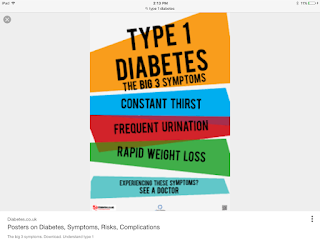Friends for life - 2018
Friends for Life 2018
We spent almost 2 days attending various sessions about the latest technologies, research and techniques of handling Type 1 diabetes. There were quite a few vendor stalls too. There were couple of key sessions about the artificial pancreas systems, which were promising as the timelines for most of these products were in years and not decades. The first session of the conference was by Prof. Damiano, the inventor of bionic pancreas (iLet) and a Type 1 Diabetic parent. His system is meant to eventually deliver both insulin and glucagon as needed by one's body. But, the current generation of iLet doesn't have the glucagon delivery capability as glucagon itself isn't widely available in a ready to use form right now. It might be released in another couple of years. One of the features of iLet is to assess the insulin need based on the time of the day and the type of the mean(small/medium/large). This eliminates the need to count carbs. The pump learns how to give the insulin based on the eating and blood glucose patterns. I had an opportunity to have a brief chat with him at the end of the talk. He showed how the iLet delivers insulin on a constant basis and how it changes the amount of delivery as the blood glucose increases. When I showed Sriram' breakfast graph, he explained when and how the pump would have intervened.
One other advantage I see with iLet is integration with Eversense continuous glucose monitoring system. The advantage with the Eversense monitoring system is that the sensor needs to be changed only once in 90 days. They are working making the sensor last for a whole year. This system is already approved for 180 day use in Europe. This kind of system would eliminate the hassle and cost of changing the sensor 10 days. This is one of the many products that are in the pipeline of research and FDA approval. I can clearly see how this would be helpful to Sriram when he starts living on his own. He wont have the hassle of changing the sensor every 10 days. Basically, one just phone call from me to check if he has changed the sensor :-)
The other session on Artificial Pancreatic systems(APS) was presented by Dr.Buckingham, head of the APS team at Stanford. Couple of interesting things he mentioned in his presentations are about finger pricks and dosage of insulin were helpful. He presented the results of his paper on how testing with the second drop of blood is more accurate than the one with the first drop after pricking. He directly correlated with the a1c results of the study participants.
The other learning for me is how the dosage of insulin delivered affects the insulin absorption. His research on this correlates the life span of the infusion set and the doses of insulin delivered. The video he showed explained the difference between how different dosages of insulin affect the skin and thereby the infusion site. This also reinforced the theory that micro-doses of bolus is lot more efficient than the bigger ones.
Dr.Buckingham explained about the various APS technologies in the pipeline. He mentioned that the next generation pumps wouldn't expect us to give a carb count. All we need to do is to broadcast to the pump that we are going to eat and the pump will take care of regulating the blood sugar. He said that there might be an app in Apple watch that tracks your hand movement and identifies that you are eating and continue to give insulin. This sounds like sci-fi for sure. I have heard in the juicebox podcast that bigfoot biomedical's pump assesses the insulin need if we feed a photo of the food before we start eating. I can clearly see that we are not too far from a day when Sriram need not count his carbs or worry about correcting the blood sugars like what we are doing right now.
Gary Scheiner. renowned author and diabetes educator was also in the conference. Senthil & I attended different sessions presented by Mr.Scheiner.
He spoke about how to interpret the CGM data effectively. The numbers a on the CGM are most likely to be lower than the actual blood glucose value when the blood glucose is dropping and its most likely to be higher than the actual value when the blood glucose is shooting up. He gave the roller coaster analogy to explain this. Basically, the CGM is in the front seat of the roller coaster. It was definitely an appropriate analogy given the fact that we were in Disneyland.
Gary Scheiner also explained about how various foods affects the blood glucose levels. For instance, eating low glycemic index foods lowers the glycemic index of the entire meal. This tip would be helpful when someone eats a mixed meal of fruits, main course, desert etc. One other fact he reiterated was the data coming out of the CGM isn't accurate during first 12 to 24 hours after a new sensor insertion.
I attended couple of sessions hosted by the Stanford Psychologists Dr. Korey Hood and his wife Dr. Diana Naranjo. Dr.Hood is a type 1 diabetic himself for over a decade. They spoke about how to handle this condition as a family.
To sum up, almost all these conversations were around "managing" diabetes. There was no mention of various projects that are undergoing for finding a cure for this condition. This was very surreal for me as a parent of a 10 year old boy who was diagnosed with Type 1 Diabetes barely 18 months back. In the weeks following his diagnosis, I googled and researched quite a bit about the various projects that are going on around the world about curing this disease. Eventually I came to a realization that there is nothing available to cure this disease at least in the foreseeable future. The only mention of "cure" in the whole conference was by Prof. Damiano. He mentioned "Care today and Cure tomorrow" as his vision. I don't know if there is a tomorrow for us. But, we have a today for sure. Sriram's blood glucose is in a fairly good control. But, this comes with a whole lot of effort from Senthil and me. I hope that the various artificial pancreatic systems would take over our role and Sriram need not worry about all the tracking and tweaking of the numbers.
Home




Comments
Post a Comment